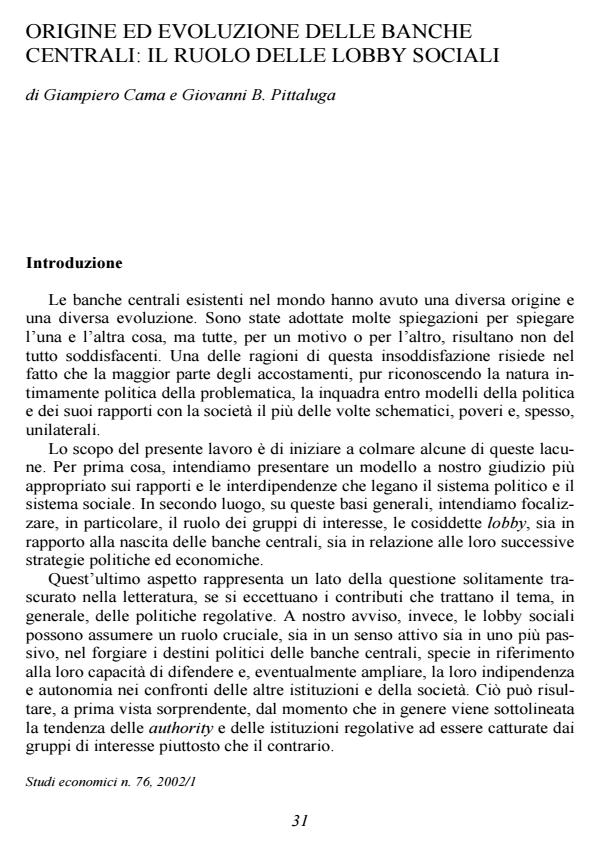Origine ed evoluzione delle banche centrali: il ruolo delle lobby sociali
Titolo Rivista STUDI ECONOMICI
Autori/Curatori Giampiero Cama, Giovanni B. Pittaluga
Anno di pubblicazione 1 Fascicolo 2002/76
Lingua Italiano Numero pagine 38 P. Dimensione file 281 KB
DOI
Il DOI è il codice a barre della proprietà intellettuale: per saperne di più
clicca qui
Qui sotto puoi vedere in anteprima la prima pagina di questo articolo.
Se questo articolo ti interessa, lo puoi acquistare (e scaricare in formato pdf) seguendo le facili indicazioni per acquistare il download credit. Acquista Download Credits per scaricare questo Articolo in formato PDF

FrancoAngeli è membro della Publishers International Linking Association, Inc (PILA)associazione indipendente e non profit per facilitare (attraverso i servizi tecnologici implementati da CrossRef.org) l’accesso degli studiosi ai contenuti digitali nelle pubblicazioni professionali e scientifiche
In order to understand public economy and the institutions which are principally responsible for it, one must refer, inevitably, to any general model of the political system and the relations which exist between this system and the social system. We started by critically examining existing models: socio-centred approach and the diametrically opposed state-centred approach. We then moved on to test the political exchange model (between social lobbies and political actors) attempting to explain the origin and development of central banks by linking them to the combined impact of two factors: the evolution of instruments of payments, with the connected transaction and political costs, and the pre-existing constitutional context prior to their creation. Specifically, we identified two models of central bank creation and evolution. One, the topbottom model, is associated to a centralised political system which originated as a result of the rapid development of a unitary nation state. The other model, bottom-top, is connected to political systems which are highly decentralised or federalised. In these circumstances local power and interest groups tend to oppose the creation of a central bank, viewing them as an expression of centralised power. This explains the delay in their formation. Even after their creation, the relation between central banks and social lobbies proved crucial. A case in point was the anti-cyclical trend, stemming from the mismatch between providers and recipients of funds, in interest rate margins which increased the aversion to inflation amongst the financial and banking community; another was the presence of a strong and concentrated private banking sector, strongly imbued with the profit philosophy, which typically proved to be a considerable source of support for central bank autonomy and monetary policies aimed at achieving price stability. Sometimes, as we have shown, the nature of the relation can also be overturned: the active role can be carried out, above all by way of its regulatory and supervisory powers, by the central bank itself to construct a favourable social environment.
Giampiero Cama, Giovanni B. Pittaluga, Origine ed evoluzione delle banche centrali: il ruolo delle lobby sociali in "STUDI ECONOMICI " 76/2002, pp , DOI: